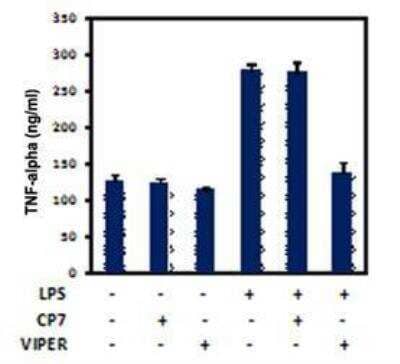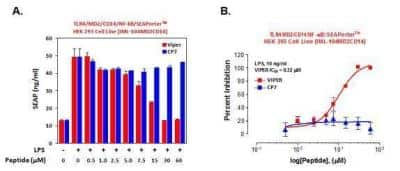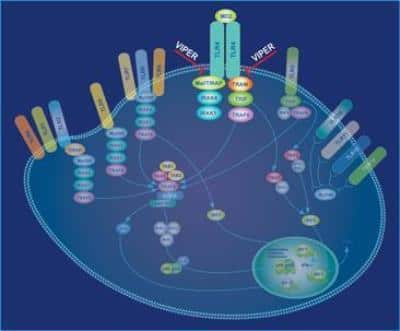TLR4 Inhibitor Peptide Set
Novus Biologicals, part of Bio-Techne | Catalog # NBP2-26244

Key Product Details
Species
Human, Mouse, Rat
Applications
Block/Neutralize, Flow Cytometry, Functional Assay
Product Summary for TLR4 Inhibitor Peptide Set
TLR4 inhibitor and control peptides are quality controlled in vitro using the TLR4/MD-2/CD14/NF-kB/SEAP cell line with SEAP as a readout assay (Image 3).
Product Specifications
Applications
Binding Inhibition (reported in scientific literature (PMID 27897392))
Block/Neutralize (reported in multiple pieces of scientific literature)
Functional (reported in scientific literature (PMID 24630524))
Block/Neutralize (reported in multiple pieces of scientific literature)
Functional (reported in scientific literature (PMID 24630524))
Application Notes
The inhibitor is used in assays to inhibit TLR4 activation; see Image 3 and also refer to Lysakova-Devine et al (2010) for examples. Optimal inhibitor concentrations should be established through titration and may vary between model systems. We recommend an initial titration from 0-30 uM for in vitro assays (Image 3). Control concentrations should mirror inhibitor concentrations. Inhibitor and control should be preincubated with cells prior to ligand activation to allow sufficient time for the peptides to enter from the media into the cell. We typically preincubate with inhibitor and control peptides for 2 h prior to TLR4 activation with LPS (Image 3); however, optimal preincubation times may vary between model systems.
The TLR4/MD-2/CD14 stably transfected cell line is a useful positive control model system for studying inhibition of TLR4 activation by VIPER (Image 3). SEAP is used as a readout assay in Image 3 to measure TLR4 inhibition.
A novel model system is shown in Image 1 where TLR4 inhibitor peptide, but not CP7, inhibited TLR4 activation in Mal-deficient immortalized mouse bone marrow-derived macrophages (iBMDMs). In these iBMDMs, the inhibitor targets TLR4-TRAM, but not TLR-Mal, interactions as Mal is not expressed. TNF-alpha is used as a readout assay in Image 1 to measure inhibition.
The TLR4/MD-2/CD14 stably transfected cell line is a useful positive control model system for studying inhibition of TLR4 activation by VIPER (Image 3). SEAP is used as a readout assay in Image 3 to measure TLR4 inhibition.
A novel model system is shown in Image 1 where TLR4 inhibitor peptide, but not CP7, inhibited TLR4 activation in Mal-deficient immortalized mouse bone marrow-derived macrophages (iBMDMs). In these iBMDMs, the inhibitor targets TLR4-TRAM, but not TLR-Mal, interactions as Mal is not expressed. TNF-alpha is used as a readout assay in Image 1 to measure inhibition.
Reactivity Notes
Rat reactivity reported in scientific literature (PMID: 25811788)
Inhibitor Content
VIPER: A TLR4 Inhibitory Peptide: 1 mg (lyophilized) KYSFKLILAEYRRRRRRRRR (VIPER sequence: KYSFKLILAEY). Molecular weight: 2780.3
CP7, Control Peptide: 1 mg (lyophilized) RNTISGNIYSARRRRRRRRR (Control sequence: RNTISGNIYSA). Molecular weight: 2601
CP7, Control Peptide: 1 mg (lyophilized) RNTISGNIYSARRRRRRRRR (Control sequence: RNTISGNIYSA). Molecular weight: 2601
Scientific Data Images for TLR4 Inhibitor Peptide Set
TLR4 Inhibitor Peptide Set [NBP2-26244] - The inhibitor peptide inhibits TLR4 signaling by blocking interactions between TLR4 and its adaptors Mal/TIRAP and TRAM.
Blocking/Neutralizing: TLR4 Inhibitor Peptide Set [NBP2-26244] - iBMDM cultures were pretreated with 5uM of inhibitor or control prior to stimulation with 20 ng/ml LPS. Negative (LPS-, LPS-/CP7+, LPS-/CP7+) and positive (LPS+) controls were also included. Supernatants were harvested after 6 h and murine TNF-alpha measured by ELISA. TLR4 inhibitor, but not the control, inhibited LPS-induced TNF-alpha production. Image courtesy of Dr. Julianne Stack and Dr. Andrew Bowie, Trinity College, Dublin, Ireland.
TLR4 Inhibitor Peptide Set [NBP2-26244] - TLR4/MD-2/CD14/NF-kB/SEAPorter stably transfected cells were plated in 96-well plates at 1x10^5 cells/well. After 16 h, cells were preincubated with various concentrations of inhibitor or control peptides (CP) for 1 h. Cells were then stimulated with 10 ng/ml LPS for 24 h. The secreted alkaline phosphatase (SEAP) was analyzed using the SEAPorter Assay Kit. Inhibitory effect on the LPS-mediated TLR4 activation by the VIPER peptide is shown in panel A, and IC50 of the VIPER peptide is described in panel B.
Formulation, Preparation, and Storage
Preparation Method
Preparation of 5 mM VIPER and CP7 Stock Solutions
Note: Bring the peptides to room temperature and quick spin the tubes before opening the caps.
VIPER: A final volume of 72 ul will make a 5 mM stock solution. Add 72 ul sterile H20 to the tube of peptide. Carefully pipet to ensure all of the peptide is dissolved.
CP7: A final volume of 76 ul will make a 5 mM stock solution. Add 76 ul sterile H20 to the tube of peptide. Carefully pipet to ensure all of the peptide is dissolved.
The stock solutions may be diluted further to make working solutions. Dilute according to the needs for your assay. For example dilute 5 mM stock solutions 1:10 in sterile 1X PBS or cell culture media to make 500 uM working solutions. Working solutions should be made fresh daily and not stored.
Note: Bring the peptides to room temperature and quick spin the tubes before opening the caps.
VIPER: A final volume of 72 ul will make a 5 mM stock solution. Add 72 ul sterile H20 to the tube of peptide. Carefully pipet to ensure all of the peptide is dissolved.
CP7: A final volume of 76 ul will make a 5 mM stock solution. Add 76 ul sterile H20 to the tube of peptide. Carefully pipet to ensure all of the peptide is dissolved.
The stock solutions may be diluted further to make working solutions. Dilute according to the needs for your assay. For example dilute 5 mM stock solutions 1:10 in sterile 1X PBS or cell culture media to make 500 uM working solutions. Working solutions should be made fresh daily and not stored.
Purification
>95%, by HPLC.
Concentration
Lyoph
Reconstitution Instructions
Please contact technical support for detailed reconstitution instructions.
Shipping
The product is shipped with polar packs. Upon receipt, store it immediately at the temperature recommended below.
Storage
Store at 4C short term. Aliquot and store at -20C long term. Avoid freeze-thaw cycles.
Background: TLR4
TLR4 signaling occurs through two distinct pathways: The MyD88 (myeloid differentiation primary response gene 88)-dependent pathway and the MyD88-independent (TRIF-dependent, TIR domain-containing adaptor inducing IFN-beta) pathway (3, 5-7). The MyD88-dependent pathway occurs mainly at the plasma membrane and involves the binding of MyD88-adaptor-like (MAL) protein followed by a signaling cascade that results in the activation of transcription factors including nuclear factor-kappaB (NF-kappaB) that promote the secretion of inflammatory molecules and increased phagocytosis (5-7). Conversely, the MyD88-independent pathway occurs after TLR4-MD2 complex internalization in the endosomal compartment. This pathway involves the binding of adapter proteins TRIF and TRIF-related adaptor molecule (TRAM), a signaling activation cascade resulting in IFN regulatory factor 3 (IRF3) translocation into the nucleus, and secretion of interferon-beta (INF-beta) genes and increased phagocytosis (5-7).
Given its expression on immune-related cells and its role in inflammation, TLR4 activation can contribute to various diseases (6-8). For instance, several studies have found that TLR4 activation is associated with neurodegeneration and several central nervous system (CNS) pathologies, including Alzheimer's disease, Parkinson's disease, and Huntington's disease (6, 7). Furthermore, TLR4 mutations have been shown to lead to higher rates of infections and increased susceptibility to sepsis (7-8). One potential therapeutic approach aimed at targeting TLR4 and neuroinflammation is polyphenolic compounds which include flavonoids and phenolic acids and alcohols (8).
Alternative names for TLR4 includes 76B357.1, ARMD10, CD284 antigen, CD284, EC 3.2.2.6, homolog of Drosophila toll, hToll, toll like receptor 4 protein, TOLL, toll-like receptor 4.
References
1. Vaure, C., & Liu, Y. (2014). A comparative review of toll-like receptor 4 expression and functionality in different animal species. Frontiers in immunology. https://doi.org/10.3389/fimmu.2014.00316
2. Park, B. S., & Lee, J. O. (2013). Recognition of lipopolysaccharide pattern by TLR4 complexes. Experimental & molecular medicine. https://doi.org/10.1038/emm.2013.97
3. Krishnan, J., Anwar, M.A., & Choi, S. (2016) TLR4 (Toll-Like Receptor 4). In: Choi S. (eds) Encyclopedia of Signaling Molecules. Springer, New York, NY. https://doi.org/10.1007/978-1-4614-6438-9_592-1
4. Botos, I., Segal, D. M., & Davies, D. R. (2011). The structural biology of Toll-like receptors. Structure. https://doi.org/10.1016/j.str.2011.02.004
5. Lu, Y. C., Yeh, W. C., & Ohashi, P. S. (2008). LPS/TLR4 signal transduction pathway. Cytokine. https://doi.org/10.1016/j.cyto.2008.01.006
6. Leitner, G. R., Wenzel, T. J., Marshall, N., Gates, E. J., & Klegeris, A. (2019). Targeting toll-like receptor 4 to modulate neuroinflammation in central nervous system disorders. Expert opinion on therapeutic targets. https://doi.org/10.1080/14728222.2019.1676416
7. Molteni, M., Gemma, S., & Rossetti, C. (2016). The Role of Toll-Like Receptor 4 in Infectious and Noninfectious Inflammation. Mediators of inflammation. https://doi.org/10.1155/2016/6978936
8. Rahimifard, M., Maqbool, F., Moeini-Nodeh, S., Niaz, K., Abdollahi, M., Braidy, N., Nabavi, S. M., & Nabavi, S. F. (2017). Targeting the TLR4 signaling pathway by polyphenols: A novel therapeutic strategy for neuroinflammation. Ageing research reviews. https://doi.org/10.1016/j.arr.2017.02.004
Long Name
Toll-like Receptor 4
Alternate Names
CD284
Gene Symbol
TLR4
Additional TLR4 Products
Product Documents for TLR4 Inhibitor Peptide Set
Product Specific Notices for TLR4 Inhibitor Peptide Set
This product is for research use only and is not approved for use in humans or in clinical diagnosis. Inhibitors are guaranteed for 1 year from date of receipt.
